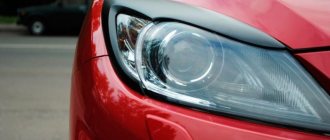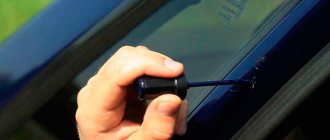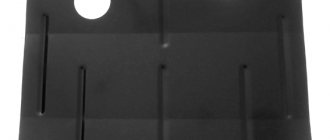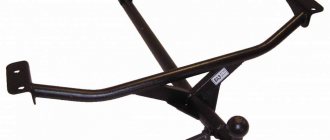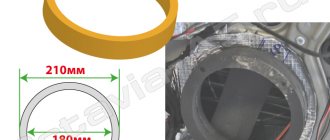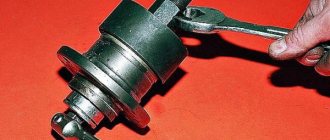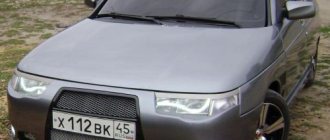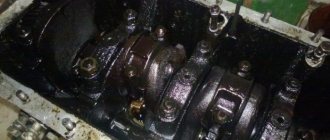Hi all! How unpleasant it is when, even with careful care, all sorts of chips, scratches and damage appear on the hood. It's a shame for those who put a lot of effort into protecting the body. Therefore, today’s material will be devoted to such a topic as protecting hoods from chips.
The main cause of damage to the hood is in front of you when you drive your car. This is gravel, sand, and wind-blown debris flying away from cars moving in front of you. In some cases, a large chip appears immediately, in others, the debris acts as an abrasive, gradually erasing and damaging the factory paintwork.
Today I will talk about how and with what you can protect the hood. In fact, all this applies to protecting the body from chips and scratches. I also advise you to read this material further.
Pros and cons of film on the hood
Automotive experts consider the hood to be one of the most vulnerable parts of the car, because all the stones on the road, dirt, bird droppings and other mechanical damage occur in this place. The hood is also susceptible to fading from the sun, which can cause the car’s factory paint to become lighter. Even small chips and scratches that appear on the hood can cause rust to form over time, which will affect the technical condition of the car.
The film on the hood is more important when buying a new car. Although those car enthusiasts who have owned a vehicle for a long time do not underestimate the importance of using such means of protecting the car specifically for the hood.
Among the positive characteristics of the hood adhesive technology, the following qualities of the film can be highlighted:
- a high-quality film may not peel off the paintwork for a long period;
- after gluing, the film does not require additional polishing or maintenance;
- performs a protective function against rust and corrosion and preserves the properties of paintwork;
- is a strong coating against chemical and mechanical intervention;
- when it rains or when cleaning the car, water does not enter under the cavities of the film;
- resistant to fading and fading;
- has thermal resistance to temperature changes;
- if necessary, can be easily dismantled;
- has a low cost;
- the gluing procedure does not take much time;
- in some cases it replaces car painting.
Disadvantages of the film pasting procedure:
- Vinyl material is not always resistant to yellowing or fading. Sometimes this requires re-gluing a certain area.
- Polyurethane film is 5 times more expensive than plain vinyl film.
How can they be removed?
Removing damage from the surface of a car body requires the use of special tools. Today, automobile stores offer a wide range of similar compounds, differing in composition and price. To choose the right product, you need to know what they are all intended for and which one is best suited for a particular car.
Selection and comparison of funds
Abrasive polishes are used to remove small stains and scratches from the body surface. They contain special substances that have cleansing properties - marble powder, clay and other components. It is thanks to them that a polished car acquires a noble appearance and a mirror-like shine.
A type of polish designed to remove minor damage from the body
After polishing, experts advise covering the surface of the body with varnish - it protects the coating, maintains shine and protects against corrosion for a long time.
Another type of damage repair product is wax. They are used most often due to their affordability. Despite the fact that they give the car an attractive appearance, they can only be used to eliminate minor scratches and imperfections in the paintwork, nothing more. Another disadvantage is that they are washed off the first time you wash the car. The most expensive and high-quality wax polishes stay on the surface of the body for a maximum of two to three visits to the car wash.
Wax compounds are one of the types of means for eliminating body defects
The third type of compounds for removing chips and scratches is synthetic compounds. They differ in their composition, and are therefore divided into three categories:
- Cleaners. They contain synthetic components that remove old paint layers and minor scratches. The result of treatment with such compounds is noticeable immediately. Cleaners are divided into two types, one of which is used for metallic paints, and the second for all other types of paints. After treatment with such compounds, the surface of the body is covered with varnish or other protective composition, which will preserve the shine of the body for two to three weeks.
A protective agent that removes traces of minor scratches, dirt and tar from the hood of a car. - Polymer compositions. Remove deep damage from plastic parts. Perhaps the most common type of product due to its advantages and properties: all defects are removed from the plastic and the body is protected at the same time. The second advantage is the durability of the coating: the shine of the body remains for two months even if the car is washed frequently. However, such polishing also has weaknesses: the process is too long and the cost of the product is high.
Designed to remove damage from plastic parts - Silicone polishes. Similar to wax products, the additional advantage is that they are low price and easy to apply to the surface of the body. The downside is the fragility of the coating.
Removing minor scratches
Surface polishing
- Before carrying out work, the car body is thoroughly washed and wiped dry. The location of all defects and problem areas - scratches, dents and chips - is noted.
A mandatory step before polishing the body is washing - Rust and dirt are removed from damaged areas. The polish is applied in a thin layer with a soft, clean sponge in a circular motion. The layer dries completely in 10–20 minutes.
Manually or automatically apply a layer of polish to the body in a circular motion - The surface treated with the composition is polished with suede or soft cloth until shiny. The remaining scratches are removed in the same way.
Rub the polish with a soft cloth until it becomes shiny. - You can remove polish from car body parts using a regular cleaner.
Video: polishing a car hood
Using wax or pencil
Minor and shallow scratches of the paintwork material are eliminated by treating with wax or pencil. Damaged areas are pre-cleaned and degreased - for this you can use gasoline or white spirit.
A pencil that can be used to remove scratches from the surface of the body
Pencil or wax is applied to the damage in several layers and then dried. The disadvantage of such products is their short service life: periodically they need to be renewed in defective areas or a layer of paint must be applied over them.
Primer and surface painting
Deep and serious chips can only be removed by priming and painting the body. Damaged areas are prepared in a similar way - cleaned and degreased.
- A layer of primer is applied over the cleaned chips. The composition used may vary depending on the nature of the damage. The layer of primer applied must be very, very thin; The product is applied with a rubber spatula and dried completely. The treated area is cleaned after the primer layer has dried. Scratches and chips are covered with an anti-corrosion primer if they are affected by rust.
Priming car body damage before painting - Painting is done over the primed area. The perimeter of the damaged area is covered with protective film or masking tape, after which paint is applied. Spray it in several layers to obtain a better and more sustainable result. Painted areas must be completely dry before polishing.
Painting damaged areas of the body using a spray gun - The last stage of processing is local polishing of the body.
The last stage of repairing body damage is polishing it.
Do I need film on the hood?
There is no point in disputing the fact that covering the hood with film actually performs a serious protective function so that additional chips and scratches do not appear on the car. Even if you prefer a careful driving style, you will not be able to protect your car from small pebbles or bird droppings. In addition, with the help of glossy or matte film, you can seriously transform your car for the better and update the appearance of the coating. But the decision whether or not to glue the film on the hood is made by each car owner independently.
The washer nozzles are frozen: how to freeze them carefully and quickly
These include the following solutions:
- ceramic coating;
- liquid rubber;
- liquid film.
Liquid rubber is called an innovative method, but you can use it yourself. It is created on the basis of a polymer-bitumen emulsion. Must be applied by spraying. After application, the surface becomes elastic, strong and durable. The easiest way to apply the product is with a spray can. Usually 2-3 layers are enough. A very common type of anti-gravel for cars.
How to choose a film for the hood
There are many options for covering the hood, including liquid film, the use of various aerosols, and branding of individual logos on parts of the hood. But as a standard, there are two main types of film – vinyl and polyurethane. Their main difference is the price, which for polyurethane is 5 times higher than regular vinyl film. But there are also other nuances for these most popular films that you need to pay attention to.
Vinyl transparent film
This is the simplest type of film, the thickness of which is about 100 microns, it is common for covering the hood and the entire car. Such a film can protect the car from minor defects in the form of pebbles, sand, moisture, etc. As a small drawback of the film, it tends to fade in the sun. The film comes in glossy and matte versions, and can become a fashionable attribute in the style of any car. You just need to remember that if a certain area of the sticker fades or becomes damaged, you will most likely have to re-stick the entire car or change a large area on the car.
Polyurethane transparent film
The urethane or polyurethane type of film is usually thicker than plain vinyl, its thickness can reach from 150 to 300 microns. Thanks to its thickness and density, this film provides better protection against scratches and damage and can withstand even larger and deeper chips. Everyone is familiar with the problem of impacts from the doors of neighboring cars, as often happens in a parking lot. It is polyurethane that will help keep the paintwork in its original form after being hit by the doors of neighboring cars.
In the same way, this film protects against impacts from supermarket carts. A very strong advantage of this coating is its ultraviolet transmission, that is, it is not subject to fading in the sun. Therefore, after the procedure, there is no need to re-stick the car frequently. But the cost of polyurethane is many times more expensive than regular vinyl film.
Video 6:00 minutes. Seminar on how to apply film to a car.
Meet the new generation Mercedes CLA Coupe
Ceramic coating can be considered a true innovation. Effective, impressive, but expensive. The hood protection level is the highest. After application, a ceramic shell effect is formed. The material is durable and wear-resistant.
There are also liquid films applied under high pressure. It is extremely easy to process the hood and edges. But you shouldn’t count on a long service life.
These are the methods of protection for the hood that I was able to cover. Do you know alternative means and methods?
Subscribe, leave comments, ask questions and tell your friends about our project!
Equipment for gluing procedure
To apply film to the hood you will need the following set of tools:
- spray guns - they are needed for additional funds required for the pasting process;
- hair dryers for working with film - when the film is heated, it will lie better on the surface, without the formation of bubbles;
- magnets and Velcro - necessary to hold the film on the selected area before covering it;
- paint rollers - will simplify the application of film to the surface and leveling of large pieces;
- degreaser - will simplify cleaning the hood surface before pasting;
- cutting tapes and knives - for easily dividing the film into certain areas.
Wax or various types of polishes are usually spread by hand to ensure even application.
Removing the film
The described version of the hood protection has many advantages. This way the film “sits” very firmly in the place where it is installed. This can create difficulties when it is necessary to free the pasted car from it. To make your work easier, in this case it is necessary to use exclusively the following methods:
- heating with a hairdryer. In this case, the protective coating is removed in the reverse order of gluing it. At the same time, you should not rush in order not to spoil the paintwork.
- using solvents to remove adhesive under the film. It is necessary to use only proven solvents, otherwise particles of varnish and paint will come off along with the film.
- using a high pressure washer.
Necessary work before the procedure
Like any work related to a car, gluing the hood with film requires additional preparation. If you do not perform the correct set of actions, the life of the film will not be long-term or the film will not initially lay down smoothly, without the formation of bubbles.
Work order:
- Before covering with film, the car must be washed thoroughly so that no pieces of dirt remain on the hood, which can cause air bubbles to form on the surface of the film. It is advisable to take your car to a professional wash for a good result.
- The surface of the hood should be thoroughly degreased using special means that will not damage the paintwork of the car. Such degreasers are indicated in the instructions for using car film.
- And the final stage before pasting includes puttying and painting problem areas, as well as thoroughly drying the surface (the film is applied only to a clean, dry surface).
Work should be carried out in a dry, warm room for better adhesion of the film to the hood parts.
How to apply anti-gravel film
The material is used more often for the front part of the body.
- Strength.
- Wear resistance.
- The protection is dense and thick.
- It lasts a long time.
The properties do not allow covering parts with curves, a protective film is installed on the car against chips, but the paintwork under the polyurethane fades in the sun.
- Degreaser.
- Napkins.
- Soft brush from 50 mm wide.
- Masking tape.
- A jar with a liquid anti-gravel coating.
- First, the car is washed, cleaned of grease, and dirt is removed.
- The viscous mixture is applied quickly.
- The headlights or radiator grille are easy to clean and you don’t have to worry about splashing them.
- Areas treated with masking tape will not be covered over.
Such protection is not pierced by pebbles or branches, washing or high pressure does not affect it. The coating is easily removed; the edge catches and is torn off by hand.
The protection is created from polyurethane and vinyl, glued to parts, and does not stand out even in bright light. Vinyl is more often used when finishing side surfaces.
- Elasticity allows application to all parts.
- The paint does not fade in the sun.
- Affordable price.
The disadvantages of vinyl protection include thickness and pliability to cold; the material breaks easily.
What are the types of chips and damage?
- Shallow scratches are polished and hidden with wax pencils.
- The middle ones are removed with paint.
- Deep ones are painted over in several layers or hidden with a pencil.
- Those that reach the metal are primed and painted.
- Defects on the bumper are painted over with a spray can.
- Chips of paint on rusty metal. First, an anti-corrosion coating is applied, then a primer and enamel.
- Deep chips are painted over, light chips are polished.
Defects on the surface are eliminated with special means, each different in purpose. Abrasive pastes help get rid of shallow defects and stains; they consist of marble powder, clay, and other substances. Used on old paintwork, cars are polished after 3 years from the date of purchase at the showroom. After this treatment, the enamel is coated with varnish to protect it from rust.
Instructions for correct hood wrapping
Of course, the film is best applied to a new car, but if your car already has surface roughness and a certain number of chips, they need to be cleaned to make the surface smooth. The procedure for this process is as follows:
- First you need to try on the material to be applied and mark the places where you will glue it.
- Taking into account the reserve, the film is cut to the required size.
- Next, you need to remove the backing and try the film on the surface.
- A soapy substance should be distributed under the film to make it easier to level the material on a slippery base.
- After leveling and squeezing out all bubbles and soap residues, the material is activated by heating with a hairdryer.
- Excess material is cut off, the remaining bubbles can be sucked out with a syringe.
- The film should be wiped with a dry cloth and left to dry.
After covering the film will dry in approximately 24 hours. The machine cannot be operated during this time.
Fabric based cover
This is the simplest and most reliable way to protect the hood. Such covers are produced by automakers and third-party companies. The price varies widely and depends on the brand of car. The cover can be very thick, which guarantees the best protection for the machine.
The main problems may arise when choosing a car for a certain brand. It should fit snugly against the hood. Leave no free space. You should also ensure that no water gets under the cover. Otherwise, the car's coating may be damaged.
Removing old film from bumper and hood
Since the film has its own period of action, over time it wears out, fades and loses its protective properties. In this case, it must be removed from the bumper plane. For this, special scrapers are used. The room for dismantling should be dry and warm (from 23 degrees), similar to the room in which the film is glued.
Wear of the film structure occurs approximately 3-4 years after gluing it. The adhesive base that remains on the hood after dismantling is removed with a special solution. After thoroughly cleaning the surface from film residues and drying the surface of the hood, the car can be re-covered with a new film.
Body surface polishing
Some drivers protect their cars with polish. But the duration and effectiveness of such protection depends on the material and substance used in the product. For example, ordinary wax polishes do not last longer than 1 month, but they are quite cheap and easy to apply.
A polish containing epoxy resin is more durable, but to apply such a composition, professional equipment is needed, for example, a polishing machine. But it lasts up to 1 year.
Polish with Teflon offers the greatest range of functions; it protects against dirt, water, and ultraviolet radiation. This coating lasts up to 3 months. But the most modern type is a nano-coated product. This substance creates a super-strong, thin film on the paint surface that protects it from mechanical stress and moisture for 3 years. It is clear that such a polish is not cheap.
Comparison of vinyl and polyurethane film
| Vinyl film | Polyurethane film | |
| Surface protection | Protects the hood from minor damage. | Advanced protection features: from small pebbles to larger mechanical damage, including auto scratches. |
| Film visibility | Yellowness begins to appear a year after pasting. | Good ability of the film not to turn yellow until the end of its service life. |
| physical characteristics | Feels like thin plastic, but may crack or tear. | It feels like a rubber coating and has increased elasticity. |
| Temperature influence | When the air temperature drops, the protective characteristics decrease. | The protective characteristics are not affected by temperature changes. |
| Solar exposure | Sunlight does not pass through the film, which preserves the surface of the car. | Capable of transmitting sunlight and fading paint. |
| Lifetime | Up to 5 years. | Up to 5 years. |
| Dismantling | Traces of adhesive may collect on the hood. | There are no traces of adhesive base. |
Why do you need body protection?
If the car is parked in a warm garage, securely covered with a thick cover, it will retain the shine and richness of the paintwork for a long time. The same cannot be said about a car that is actively used. Every thousand kilometers traveled adds dozens of scratches, chips, and microscopic cracks to the appearance of the “iron horse.”
Great damage to the “native” car coating is caused by birds whose droppings contain acid that corrodes the varnish. Precipitation and bright rays of the sun are no less harmful. In winter, things are even worse: tons of chemicals poured onto the roads corrode everything in their path. Under their influence, car paint fades and cracks.
This problem has become especially urgent in the last four to five years, when, under the influence of environmental standards, manufacturers began to coat cars with less durable varnishes than before. Even a small grain of sand stuck in a sponge or rag used to wipe the body can leave a generous mark on the car. What can we say about “surprises” left by neighbors in the parking lot or pebbles that fly from under the wheels of cars in front.
Additional body protection helps minimize all negative impacts on the paintwork.
What is the best film to apply to a car?
Car film can be applied both to the entire car and to individual parts of the body that are most sensitive to damage. Such parts in a car are usually the front part of the hood, bumper, and the front part of the wings. The film helps preserve the car’s paint layer in its original form, which not only protects against rust, but also transforms the car aesthetically. Such adhesive will also act as a softening barrier against scratches that may be caused by neighboring cars.
Today, the best protection for your car is polyurethane film (cost in Moscow is 3,500 rubles per square meter), but you need to keep in mind that its cost is five times more expensive than vinyl film. But in some cases these expenses are justified, especially if your car is used in harsh conditions, where there is an increased likelihood of mechanical damage. And the appearance of your car after wrapping will bring you pleasure.
Liquid film
Liquid film is usually applied by professionals because its composition resembles varnish. An even layer of liquid glass dries up to 3 days, but then the coating protects the paint from all possible attacks - ultraviolet radiation, sand, gravel, water and dirt. It is expensive, but the coating lasts up to 1 year. Moreover, under this coating the paint becomes brighter, and the car sparkles like new in any weather.
The choice of paint protection is best left to professionals, since everything depends not only on the price, but also on the quality and type of paint on the car. You also need to consider why exactly the coating is being applied, in what environment the car is planned to be used - a forest, a desert or the streets of a snow-covered city.
- Author: Alexey Vinokurov
Rate this article:
- 5
- 4
- 3
- 2
- 1
(1 vote, average: 5 out of 5)
Share with your friends!
What is a protective film, what is it like and what is it needed for?
Based on the name, it becomes clear that such a film is designed to protect the car from damage. In addition, it performs a decorative function.
You can completely cover the car with protective film or some of its elements
Protective film for cars can be of several types:
- vinyl, has a reasonable price and a large selection, but does not protect the car very reliably. Its thickness is up to 90 microns;
- carbon - one of the types of vinyl film;
- Vinylography is a film on which drawings are printed;
- polyurethane, it is stronger than vinyl film, but does not retain its shape well and is not suitable for pasting spherical surfaces;
- anti-gravel - reliably protects the car from damage by sand and gravel. The thickness of the film is up to 200 microns, while the thickness of the paint coating is 130–150 microns.
